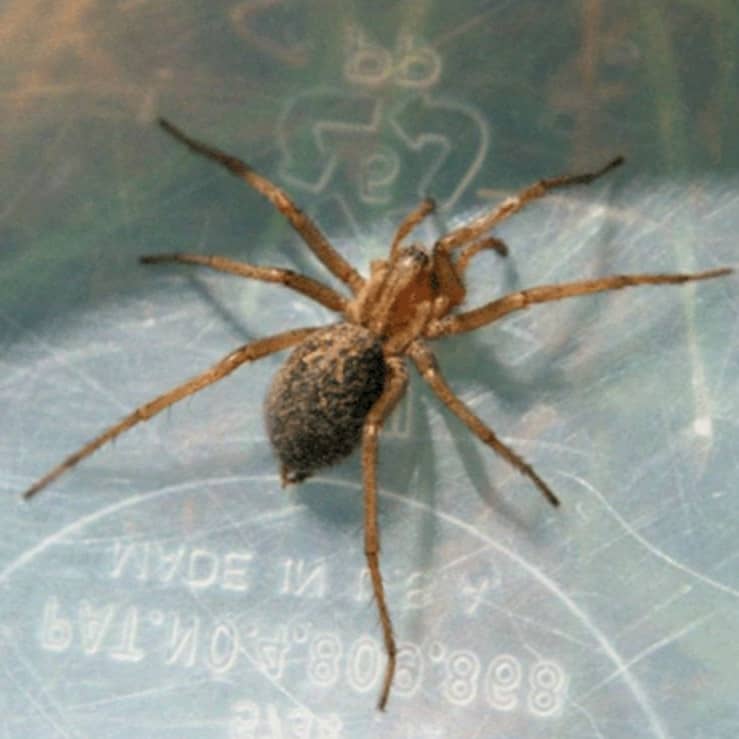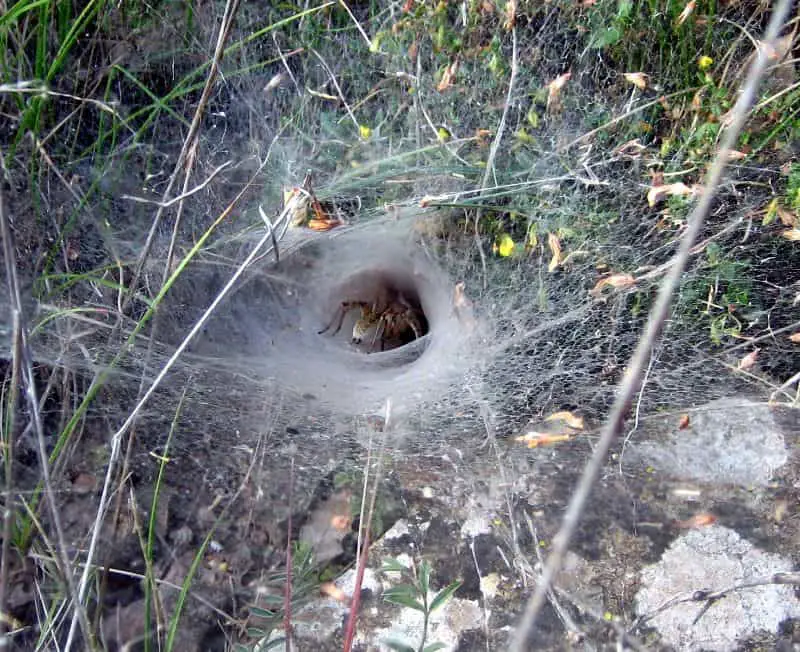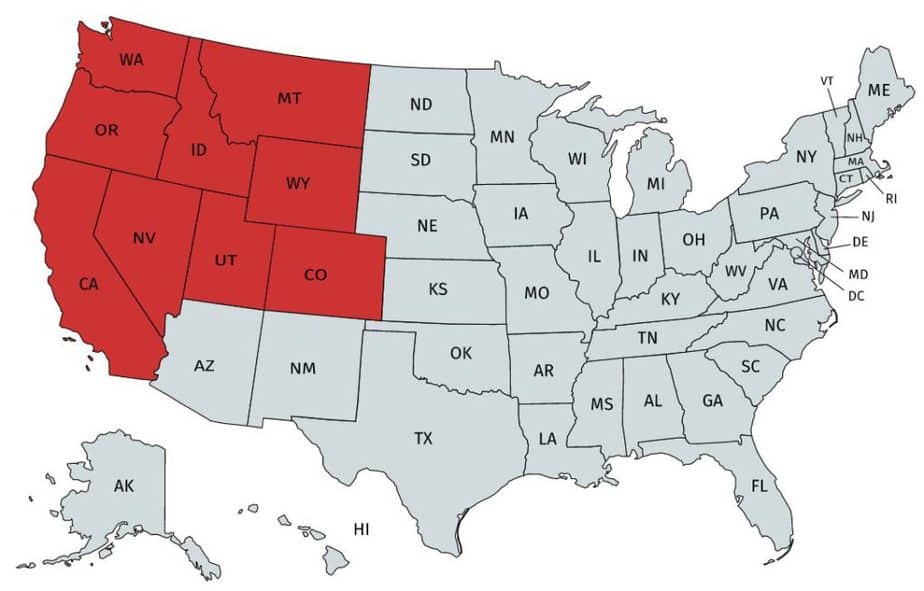Eratigena agrestis, commonly know as the hobo spider, is a funnel web spider that can be found in the Pacific Northwest. In the 90ies, the hobo spider has been listed as a medically important species. However, over the last 30 years, no actual evidence has been found that the spider is actually dangerous for humans. In 2017, the CDC removed the hobo spider from its list of dangerous spiders.
Hobo Spider Description
Even experienced arachnologists have difficulties identifying a hobo spider without a microscopic examination. The hobo spider itself comes in several appearances, as do other, similar looking related spiders like the closely-related giant house spider, the wolf spider or the grass spider.
Here are a few tips how you can identify a hobo spider:
- Most similar looking species like wolf spiders have colored bandy at the joints where they legs meet the body. The hobo spider does not have any of these band.
- The abdomen of the hobo spider has several v-shaped dark patterns that point towards the head of the spider. However, similar patters also occur in some fishing spiders.
- Most similar-looking spiders like wolf spiders and grass spiders have two dark parallel stripes running from their eyes back to their abdomen. Hobo spiders do not have two clear lines.
- The closely related giant house spiders also occur in the Pacific Northwest and have similar markings on the abdomen. Hobo spiders are generally smaller and have shorter legs than giant house spiders, Eratigena atrica.

Size
The body of a hobo spider can reach a length of up to 0.6 inches (15 mm) and a total size including its legs of around 2 inches.
Web
As mentioned above, hobo spiders are part of the funnel web spider family. This means that they do not build a normal open web to catch prey but a funnel-shaped web. The web is non-sticky but full of small ligaments where any prey can get stuck in. Due to the elasticity of the web, a hobo spider will realize immediately once something touches its web and can race there to attack the prey.

Bite
As mentioned above, the hobo spider was defined as medically important in the 1980ies after reports of bits that apparently caused necrosis. And even though the hobo spider is often seen around humans and there are numerous claims of bites, not a single severe case has been reported since the 1990ies. Therefore, it is now no longer considered dangerous and was removed from the CDC list of dangerous spiders in 2017.
A bite will mostly still cause local swellings and pain comparable to a painful bee sting.
Eratigena agrestis scientific classification
- Kingdom: Animalia
- Phylum: Arthropoda
- Subphylum: Chelicerata
- Class: Arachnida
- Order: Araneae
- Infraorder: Araneomorphae
- Family: Agelenidae
- Genus: Eratigena
- Species: Eratigena agrestis
Eratigena agrestis Distribution in the US

As mentioned, the hobo spider occurs almost exclusively in the Pacific Northwest. Almost all sightings come from Washington, Oregon, Idaho, Montana, Utah and Wyoming. Occasionally, they also appear in Northern California, Nevada and in Colorado.


Found this guy (or girl) in my backyard after moving my BBQ. Thinking it is either a giant house spider or a hobo. Any ideas?
Sandy, Utah
About 1.5 inches including legs.
Hello Anthony, thanks for getting in touch! I agree with your guesses about the ID of this spider. Given the coloration of the legs and patterns, I am leaning towards hobo spider (Eratigena agrestis) but the identification for them is hard based on pictures alone.
Despite their bad reputation, there is no indication that Eratigena agrestis is medically significant.
I have no idea what these are but I see them all the time in my basement!
I couldn’t tell if anyone had identified this for you yet, but looks like a woodlouse hunter
Found in the bathroom, scared the sh$t out of my parter. I’m not sure what it is but it was quite large (body longer than a quarter but not thicker than)
This big spider was found in the house alone the outside of the bathtub. It’s just over one inch long.
Gary, Indiana USA
Hello “Spider Hater”, no need to hate this fellow 🙂 this is a harmless wolf spider (Lycosidae): https://usaspiders.com/lycosidae-wolf-spider/
Hello Kai, thanks for getting in touch! This is some type of funnel weaving spider (Agelenidae), most likely in the genus Eratigena. My guess would be hobo spider (Eratigena agrestis): https://usaspiders.com/eratigena-agrestis-hobo-spider/
Despite their bad reputation, hobo spiders are not medically significant and no more “dangerous” than most harmless spiders – with venom no more potent than a bee or wasp.
Could you attempt to identify this spider. It was dark brown with legs a little to long for it’s body. It had no specific markings on it’s back and wasn’t very fast. I live in North West Montana.
This is the second one of these guys we’ve found in the house in the last week. Largish, about 2 inches across (including legs). Both times on the walls. In Northern California. Wolf, grass, or something else?
Elan — looks like the giant house spider, a male. We have them in our basement in WA. Big, but totally harmless.
Elan, this looks like the giant house spider (Eratigena atrica), prob a male. We have them in our basement in WA. Big, but totally harmless.
Not sure what this is. Hobo, giant ? Found in Washington state. 1-2inches long, incredibly fast. Disjointed webbing.
Keep finding these spiders indoors, they run fast and come in all types of sizes.